They did something wrong (and something right)
Causal’s misstep with SEO—and the smart move that followed
👋 Hey, I’m George Chasiotis. Welcome to GrowthWaves, your weekly dose of B2B growth insights—featuring powerful case studies, emerging trends, and unconventional strategies you won’t find anywhere else.
Have you noticed this trend?
When someone makes a mistake in a company’s growth strategy, it immediately comes under intense scrutiny.
Everyone writes case studies, LinkedIn posts, or tweets about it, discussing what was done wrong and what should have been done instead.
However, someone rarely moves past that to see what the company did to recover from its mistake.
This, in my opinion, can give you a better perspective on the growth lesson you can draw from such occurrences.
Today’s GrowthWaves Note covers a situation like this.
Let’s explore it and see what we can learn from it.
Key findings
Let me first give you a quick overview of the Note.
The company under analysis is Causal. It’s a finance platform for startups that allows you to track all budgeting and forecasting reports in one place.
In April 2022, Causal pulled off an “SEO heist.” With the help of Jake Ward from Contact Studios, the company managed to boost its organic traffic to 450K in 18 months.
The “heist” was not successful. After reaching almost 450K in organic clicks in October 2023, Causal’s traffic plummeted to pre-campaign numbers (around 2K monthly organic visits) within two months.
Causal chose product-led growth to remedy the situation. The company used public growth metrics from two well-known companies to build reusable models with the help of its product.
The company’s efforts didn’t go unnoticed. The CEO of one of the two companies shared Causal’s report, drawing public attention to its product.
Sounds like a great case, right?
Let’s dive into the specifics.
An unsuccessful SEO heist
Act in haste, repent in leisure.
This proverb basically describes the outcome of Causal’s campaign, which they bullishly called an SEO heist (read: traffic snatching).
So, what happened?
Back in November 2023, Jake Ward, the owner of Contact Studios (an SEO agency), published a thread on X detailing a campaign he ran for a client (Causal).
I admit, it sounded impressive — Causal’s traffic reached almost 450K in October 2023 as the result of this “heist.”
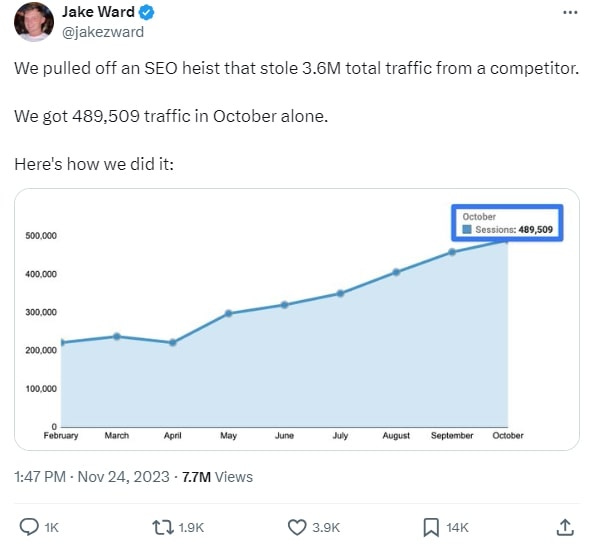
In a thread below his tweet, he explained the master plan that went into this campaign.
Just for a quick overview, I’ve put the entire process together in the graph below.
Over 18 months of this campaign (the timeline shared by Jake Ward in his tweet), specifically from April 2022 to October 2023, Causal posted 1,800 articles.
For objectivity purposes, I checked whether Causal’s articles within the 18-month period were really crafted with AI help.
The three free AI detection tools (Copyleaks, Scribbr, and Hive) I used for the article on best practices for financial planning all confirmed the pieces were not written or edited by a human.
Editor’s Note: Take these results with a grain of salt since no AI content detection tool is 100% accurate.
These content pieces brought a relatively quick win for Causal’s traffic, which grew from 6K to 426K over the course of the campaign.
Unfortunately, hasty climbers have sudden falls.
By the time Jake Ward posted his tweet (24 November 2023), traffic had already started declining, as the graph above shows.
In December 2023, the traffic returned to the pre-campaign figures, reaching no more than 2K organic clicks monthly (according to Ahrefs).
Why did the “heist” flop?
Arrogant and overconfident approach to implementation.
Basically, this “heist” pumped a SaaS site with tons of irrelevant traffic through low-quality content that neither carried any value nor captured or nurtured quality leads for Causal.
Needless to say, Google didn’t let this one slide.
In the comments to his thread, Jake Ward shared that the website got a manual penalty (which he blamed on him making the campaign’s results public).

Is it possible to recover from this?
This “heist” was definitely a bad decision, but Causal took steps to improve the situation.
Let’s explore what they did.
Choosing the direction of Product-Led Growth
Causal’s main asset is its product.
Talking about it in blog content could bring in some leads, of course.
However, if I were looking for a similar tool, I’d want to see it in action, not just read about it.
That’s exactly the direction Causal decided to follow.
Let me explain.
Recently, while browsing Causal’s website, I came across the Templates page, where the brand publishes reporting models covering different scenarios, like hiring plans, cohort analysis, etc.
Among these models popped a report detailing ConvertKit’s growth from $0 to $40M ARR.

This report was created using Causal’s modeling tool, which allows you to build templates for different scenarios.
In this case, it’s a revenue growth template.
Right off the bat, the first thing that meets the eye is how highly interactive this report is.
You can easily:
Track ConvertKit’s ARR and customer growth over the years;
Compare churned, new, expansion, reactivation, and contraction ARR;
Separate revenue metrics like net dollar retention, MRR, lifetime value, and average revenue per user.
Moreover, it’s possible to set a timeline to review these metrics over a certain period.
I played around with it a bit just to show you what it looks like.

ConvertKit’s report wasn’t the only one of its kind.
Causal created one for Tesla, covering three years of historical financials (e.g., revenue, summary income statement, and so on.).
This report is also interactive and allows you to review metrics within pre-set timelines.
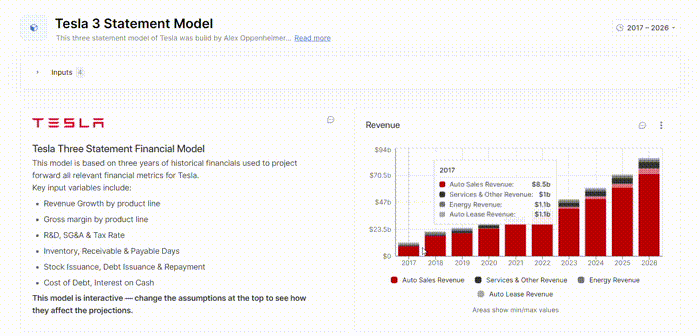
Now, where does Causal source this information from?
It seems that the data in both cases can be accessed online for free.
For instance, ConvertKit’s revenue data is openly available on Baremetrics.
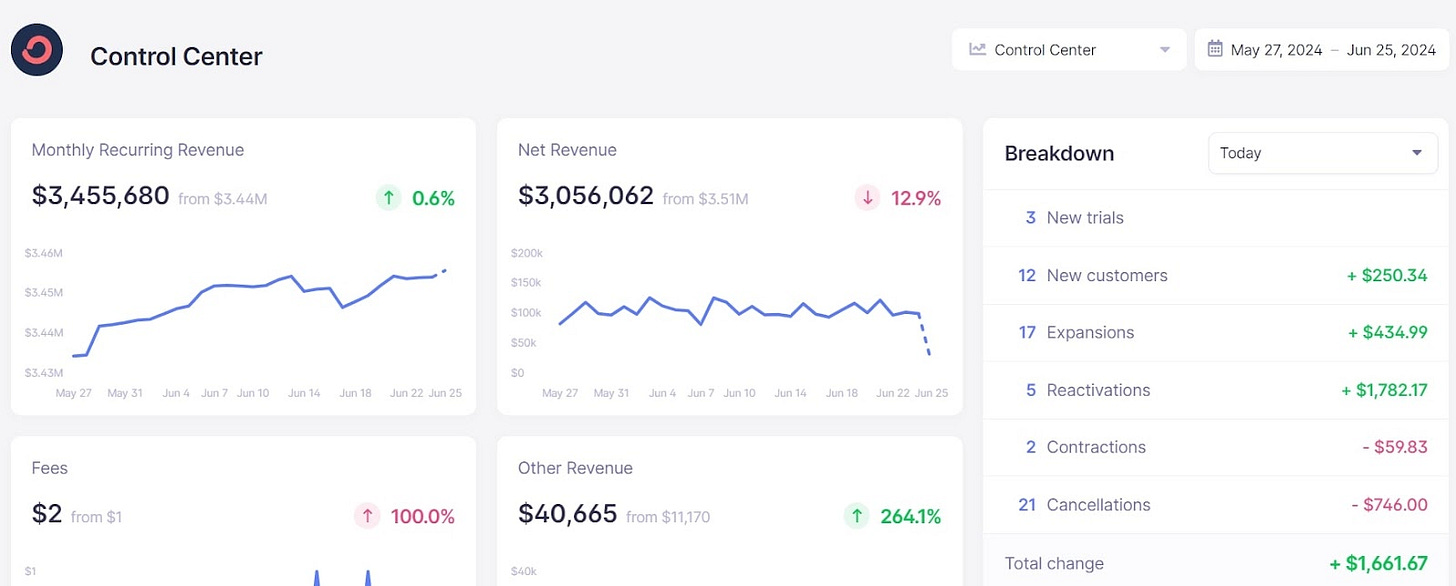
In turn, Tesla’s profitability reports throughout the years can be found on its website under Investor Relations.
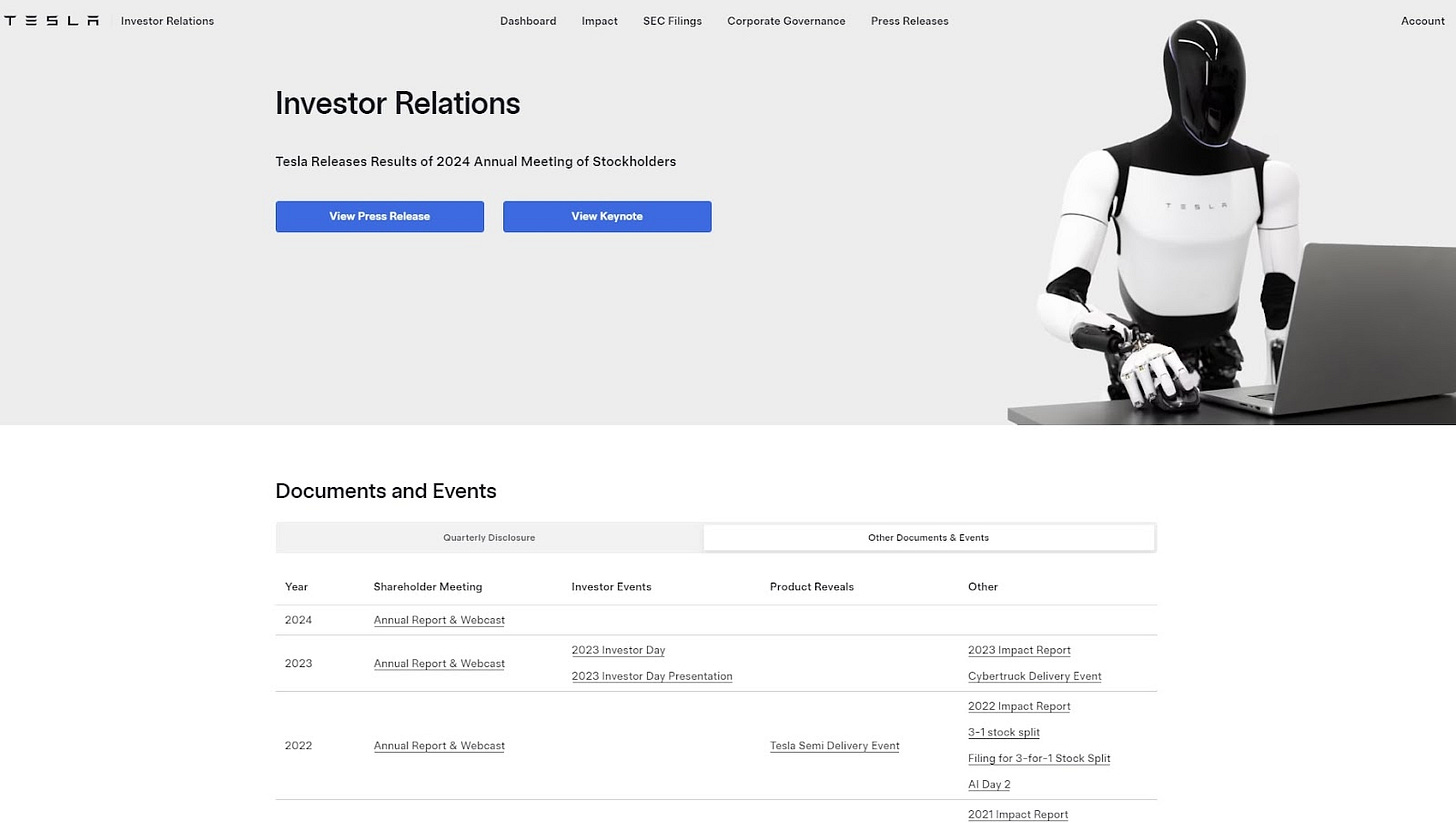
So, we can assume that, to demonstrate its product “in action,” Causal used open-access data from well-known companies and built models any business owner will find applicable.
More importantly, a potential customer can play around with these models to see how Causal’s tool presents the aggregated data.
That’s definitely the right move towards product-led growth.
But did it bring any results in terms of leads or visibility?
The outcome
Although it's unknown whether this content brought Causal any new customers, the creation of ConvertKit’s report did not go unnoticed.
It was picked up by Nathan Barry, the Founder and CEO at ConvertKit, who posted about it on his X profile:

… and via his LinkedIn account:
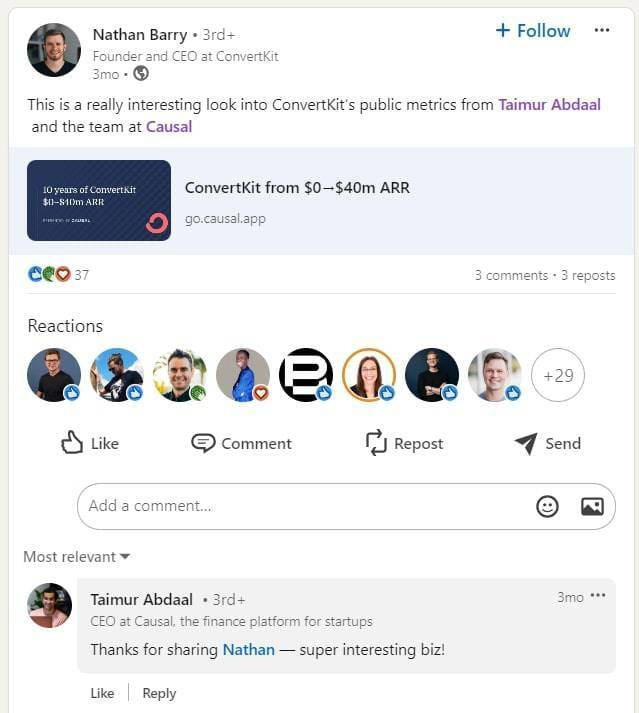
Both posts received attention, especially Nathan’s tweet—61.8K views and 239 engagements.
By the way, in his post on X, Nathan specified that Causal had used ConvertKit’s public metrics, proving my assumptions regarding data sources.
The comments under Nathan’s tweet overwhelmingly praise Causal’s tool for its interactivity and apt data representation.
What’s more important, however, is that many of them come from company and agency owners, like Steven Tay from Dub.co (open-source link management infrastructure) and Caleb Wojcik, Co-Founder of SwitchPod (tripod manufacturer).
This small but important detail already shows that Causal has chosen the right path toward product-led growth.
The potential of content like ConvertKit’s or Tesla’s reports to drive high-quality leads, especially when shared by the right people and through the right channels, is immense.
That’s why Causal decided to capitalize on such content even more.
Obviously, not every company has its growth and revenue data in open access, so Causal decided to bypass that and create a set of customizable templates for general use instead.
For this purpose, the company partnered with Packy McCormick from Not Boring (a media and venture capital firm).
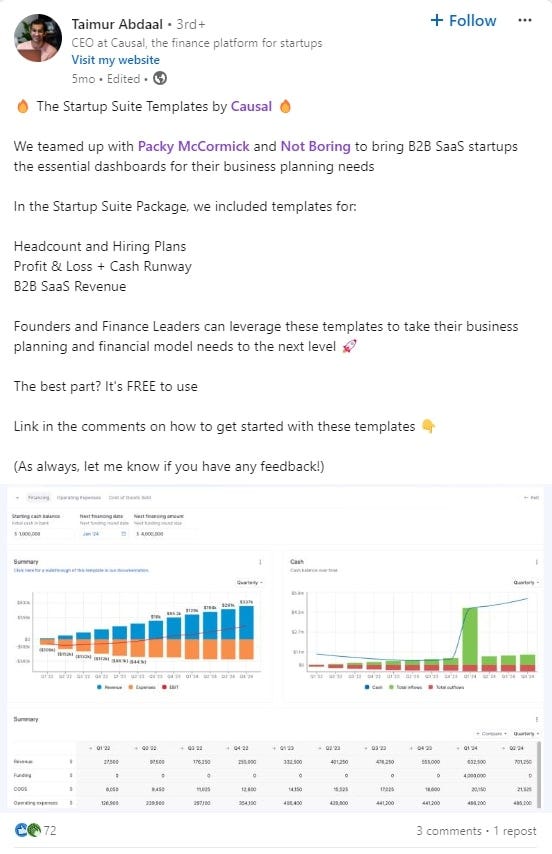
Together, they’ve built a set of three templates for Causal’s Startup Suite package.
Here’s their overview.
These models are free and available to Causal users (both free and paid) via the Templates page under Resources.
Aside from simply being a helpful resource, these templates specifically target startup founders and finance leaders—the target audience for Causal’s product (according to the company’s homepage).
That’s definitely the right direction for Causal to move toward.
Conclusion
This story teaches a very important lesson.
A bad choice in a growth strategy doesn’t necessarily define its outcome (although it can have undesirable short-term effects).
What’s more important is the ability to pick yourself up, dust yourself off, and come to the right conclusion.
In Causal’s case, the company did make the wrong choice which killed its growth in terms of organic traffic.
However, it also made the timely decision to pivot towards product-led growth, showcasing its toolkit’s functionality in a practical way.
That’s definitely what their potential customers want.
See you next week!






